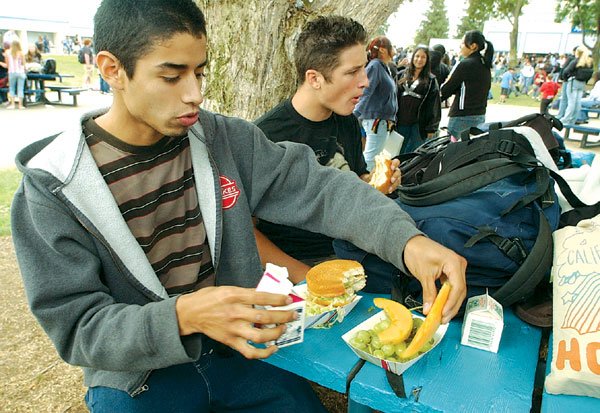With soda and junk food no longer sold, Gilroy High students
encouraged to eat balanced meals
Gilroy – Would you like some juice with those fries?
Students at Gilroy High School may have noticed a few changes this school year – no soda in vending machines and food service workers encouraging them to eat balanced meals on campus – handing out fruit and yogurt with Pop-Tarts at breakfast, and milk and salad with French fries at lunch.
The practice began just as two senate bills prohibiting the sale of soda and junk food passed in both the House of Representatives and state Senate earlier this month. Gov. Arnold Schwarzenegger sponsored both measures and is expected to sign both SB 12 and SB 965 into law.
“This is a whole new way for us to serve,” said GHS Food Service Supervisor Jody Orneles-Canali. “We were proactive at this stage – we knew this was going to happen.”
For $2.25, students can purchase an entree such as a hamburger or chicken sandwich served with a quarter cup of French fries, salad, fresh fruit, and a carton of 100 percent juice and lowfat milk.
A once popular chocolate muffin was eliminated from the breakfast menu, along with anything else containing chocolate or chocolate chips. A salad bar was added to the menu.
Senate Bill 12 prohibits the sale of individual sold snacks containing more than 250 calories, or that contain 35 percent sugar by weight, 10 percent of its calories from saturated fat, and 35 percent of its calories from fat. An entree must not contain more than 400 calories or four grams of fat per 100 calories.
In 2003, soda and sugary beverages were eliminated from elementary and middle school campuses. Senate Bill 965 adds high schools to the list, however, students may bring the beverages on campus.
Fried potato chips have disappeared from the racks and replaced with Baked Lays, Baked Cheetos and granola bars.
There is only one location on campus where students can purchase just a container of French fries – the snack windows – but even there, food workers are pushing full meals instead.
Orneles-Canali refuses to open a separate line.
“A lunch is not French fries and a drink,” she said. “We’re trying to teach them good eating habits. Kids don’t know what they’re doing to their bodies.”
But for most students, the new menus are a welcome change.
Junior Eric Esparza’s lunch Thursday was a chicken patty sandwich, milk and juice, French fries and salad, with a side of cantaloupe and grapes.
“I enjoy the fruit,” he said. “They used to have chocolate muffins – what kind of breakfast is that?”
Another student, sophomore Kayla Garcia, supports the move to a healthier menu, but with one alteration.
“I kind of miss soda,” she said. “I thought it was kind of dumb that they got rid of soda, but still have the fatty foods … I’m tired of eating all the fatty foods so I bring a salad.”
She isn’t the only one still reminiscing about the days when soda at least flowed on the campus.
“I would rather exchange cheese fries for soda,” said sophomore Janet Yamamoto. “People are saying that they’re going to start selling soda.”
But that may just rumor or wishful thinking – because water and SoBe juice sales have been strong since last week.
However, sales of actual snacks from vending machines are down, said Don McFarland, owner of Don’s Vending who has a contract with GUSD. He also services Morgan Hill Unified School District and experienced a loss of sales when they removed junk food from vending machines about two years ago.
“When my sales in Morgan Hill dropped, they never came back up,” he said. “Nothing that substitutes candy is doing well.”
Despite the financial loss, McFarland acknowledged the importance of the bills.
“I think it’s good as much as it hurts my pocket – but I think it should be across the board,” he said. McFarland believes students should not be allowed to bring junk food or soda onto the campus at all.
“It’s almost like a drug. Students wanted it before, but now it’s illegal to sell (so they really want it now,) he said.
A number of students commented that the food tasted better than last year. But despite the mainly positive feedback, some insisted that a box of French fries and SoBe is lunch.
So be it.
Numerous studies have linked diets high in sugars and an increased likelihood of childhood obesity.
According to analysis of the California Department of Education’s 2004 fitness program data, 32 percent of students are overweight and about 75 percent are unfit. In April, the CDE published a paper called Healthy Children Ready to Learn promoting the creation of school environments supportive of student health.
“What you’re eating as a child is going to affect you as an adult,” said Assembly Member Simón Salinas (D-Salinas) who supported both bills for health reasons. “We’re seeing the impact of childhood obesity with chronic diseases … I think (the legislation) is certainly changing attitudes.”
Many students in Gilroy Unified School District consume both breakfast and lunch on campus. But when the final bell rings, school officials cannot limit what they purchase.
So Salinas is calling on parents to continue the healthy trends.
“Why wouldn’t you want to give your children foods that are going to make them smarter?” he asked.















